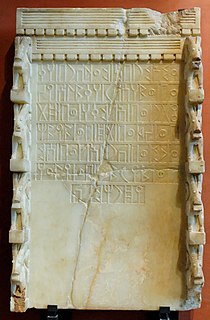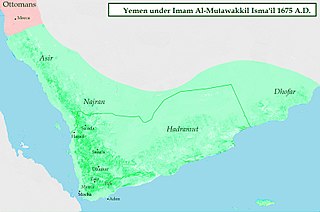 W
WThe history of Yemen describes the cultures, events, and peoples of what is one of the oldest centers of civilization in the Near East. Its relatively fertile land and adequate rainfall in a moister climate helped sustain a stable population, a feature recognized by the ancient Greek geographer Ptolemy, who described Yemen as Eudaimon Arabia meaning "fortunate Arabia" or "Happy Arabia". Yemenis had developed the South Arabian alphabet by the 12th to 8th centuries BCE, which explains why most historians date all of the ancient Yemeni kingdoms to that era.
 W
WAl Luḩayyah is a town on the Tihamah coastal plain, Yemen. It is located at around 15°42′14″N 42°41′31″E. The port lies 4 miles (6 km) southwest of Al Luḩayyah, partially protected by the offshore island of Al-Urmak.
 W
WAwwam can refer to the region of ʾAwwām, now thought by most scholars to be Ma'rib, or to the famous temple of ʾAwwām otherwise known as the Maḥram Bilqis. In the pre-Islamic times, numerous pilgrims gathered in Ma'rib city and headed to almaqah temple of Harunum to perform their cultic rituals, and continued to the sanctuary of Awwam using processional road.
 W
WJamal Ahmad Mohammad Ali Al Badawi aka Jamal Abu Abed Al Rahman Al Badawi was a Yemeni who was indicted as an accomplice for his role in the 2000 USS Cole bombing off the coast of Aden, Yemen, which killed 17 American sailors on October 12, 2000. He was captured in Yemen and sentenced to death on September 29, 2004. Al-Badawi was also indicted on May 15, 2003, by the United States for the USS Cole bombing and the attempted attack on USS The Sullivans. He is thought to have travelled to Saudi Arabia and purchased a small boat and then a truck and trailer to transport it. This boat sank from the weight of the explosives while preparing the USS The Sullivans plot. Al-Badawi is also thought to have leased the safehouses used in these endeavors. Fox News called Al-Badawi a "mastermind" of the Cole bombing.
 W
WTemple of Barran is a Sabaean temple near Ma'rib, Yemen; also known as "Throne of Bilqis", it was dedicated to the god al-Maqah.
 W
WHermann Burchardt was a German explorer and photographer of Jewish descent, who is renowned for his black and white pictorial essays of scenes in Arabia in the early 20th century.
 W
WCheikh Said is a rocky peninsula in Yemen, near the island of Perim on the Bab-el-Mandeb at the entrance to the Red Sea. In 1868 it was purchased from the local ruler, Sheikh Ali Tabet Ahmed, by Bazin et Rabaud, a private company based in Marseille in France, which wanted to use it as a base for exporting coffee. The purchase price was 80,000 thalers. In 1869, the sheikh annulled the agreement as he had received only 18,000 thalers. Bazin et Rabaud and some allies in the French press attempted to press the French government to intervene, without success. In 1920, Cheikh Saïd was described as a "good landing-place, with an important telegraph station." Although as late as 1970, the Petit Larousse described it as having been a "French colony from 1868 to 1936", France never claimed formal jurisdiction or sovereignty over it.
 W
WThe Cisterns of Tawila, or the Tawila Tanks, are the best-known historic site in Aden, Yemen. The site consists of a series of tanks of varying shape and capacity. They are connected to one another and located in Wadi Tawila to the southwest of Aden’s oldest district, Crater. Originally there were about 53 tanks, but only 13 remain following a succession of renovations, including those done by the British in the 19th century. The existing tanks have a combined capacity of about nineteen million gallons. The tanks were designed to collect and store the rain that flows down from the Shamsan massif through Wadi Tawila, and to protect the city from periodic flooding. The largest of the tanks are the Coghlan Tank at the center of the main site and the large, circular Playfair Tank, located at the lowest point, outside the main site.
 W
WThe Deputy Prime Minister of the Republic of Yemen is the deputy head of government of Yemen.
 W
WEduard Glaser was an Austrian Arabist and archaeologist. He was one of the first Europeans to explore South Arabia. He collected thousands of inscriptions in Yemen that are today held by the Kunsthistorisches Museum in Vienna, Austria.
 W
WHadhramaut is a region in South Arabia, located mostly in present-day eastern Yemen. The name is of ancient origin, and is retained in the name of the Hadhramaut Governorate of Yemen. The people of Hadhramaut are called Hadhrami. They formerly spoke Hadramautic, but now predominantly speak Hadhrami Arabic.
 W
WThe Hadrami or Hadhrami Sheikdom, Maktab Al Hadharem, or Al Hadharem, is one of the five sheikdoms of Upper Yafa. The Hadrami sheikdom was divided into four quarters: Sinaani (سناني), Bal Hay (بلحأي), Thuluthi (ثلثي), and Marfadi (مرفدي). The capital of the sheikdom is the village of Al-Shibr, which is located in the Sinaani quarter.
 W
WThe Mahra Sultanate, known in its later years as the Mahra State of Qishn and Socotra or sometimes the Mahra Sultanate of Ghayda and Socotra was a sultanate that included the historical region of Mahra and the Guardafui Channel island of Socotra in what is now eastern Yemen. It was ruled by the Banu Afrar dynasty for most of its history.
 W
WThe Exile of Mawzaʻ Hebrew: גלות מוזע, pronounced [ğalūt mawzaʻ]; 1679–1680, is considered the single most traumatic event experienced collectively by the Jews of Yemen, in which Jews living in nearly all cities and towns throughout Yemen were banished by decree of the king, Imām al-Mahdi Ahmad, and sent to a dry and barren region of the country named Mawzaʻ to withstand their fate or to die. Only a few communities, viz., those Jewish inhabitants who lived in the far eastern quarters of Yemen were spared this fate by virtue of their Arab patrons who refused to obey the king's orders. Many would die along the route and while confined to the hot and arid conditions of this forbidding terrain. After one year in exile, the exiles were called back to perform their usual tasks and labors for the indigenous Arab populations, who had been deprived of goods and services on account of their exile.
 W
WThe National Dialogue Conference (NDC) was a transitional dialogue process held at the Movenpick Hotel in Sana'a, Yemen from March 18, 2013 to January 24, 2014, as part of the Yemeni crisis reconciliation efforts.
 W
WThe President of the Yemen Arab Republic was the head of state in the former North Yemen from 1962 to 1990. There were six presidents of North Yemen.
 W
WThe president of the Republic of Yemen is the head of state of Yemen. Under the Constitution of Yemen, the president is also the Supreme Commander of the Armed Forces and head of the executive branch of the Yemeni government.
 W
WThe Prime Minister of the Mutawakkilite Kingdom of Yemen was the head of government of that country in what is now northern Yemen. The Prime Minister was appointed by the King. There were seven prime ministers of North Yemen.
 W
WThe prime minister of the Republic of Yemen is the head of government of Yemen.
 W
WThe prime minister of the Yemen Arab Republic was the head of government of that country in what is now northern Yemen. The Prime Minister was appointed by the President. There were twelve prime ministers of North Yemen.
 W
WThe terms Qahtanite and Qahtani refer to Arabs who originate from Yemen.
 W
WQarnāwu is the name of an ancient city situated in present day Jawf in the north of Yemen, near the modern city of Ma'īn.
 W
WQu'aiti or the Qu'aiti Sultanate of Shihr and Mukalla, was a sultanate in the Hadhramaut region of the southern Arabian Peninsula, in what is now Yemen. Its capital was Mukalla, and it was divided into six provinces including Al-Mukalla, Ash-Shihr, Shibam, Du'an, the Western Province and Hajr. Apart from Al-Mukalla, Ash-Shihr and Shibam were the Sultanate's major cities.
 W
WRadfan or the Radfan Hills is a region of the Republic of Yemen. In the 1960s, the area was part of a British protectorate of Dhala and was the site of intense fighting during the Aden Emergency. In 1964, local Qutaibi tribespeople attacked the British on the Aden to Mecca caravan route which passed through the nearby town Dhala. The tribespeople had traditionally collected tolls from passing caravans, but the implementation of the customs union of the Federation of South Arabia in 1962 put a stop to this. The tribespeople resented the loss of this income.
 W
WThe Sheikhdom of al-Hawra was a state of the Protectorate of South Arabia which existed from the 19th century to 1967. It became a British protectorate in 1888.
 W
WThe Sheikhdom of al-ʽIrqa was a city-state which was part of the Protectorate of South Arabia, and existed from the 19th century to 1951.
 W
WSubeihi or Subayhi, or the Subeihi Sultanate, was the westernmost state in the western Aden Protectorate. It was one of the original "Nine Cantons" that signed protection agreements with Great Britain in the late 19th century.
 W
WThe Sultanate of Tarim was a state in Yemen created after a division of power within the Kathiri sultanate in 1916. It was first ruled by Muhsin ibn Ghalib al-Kathiri. Jam'iyat al-Haqq was responsible for civil affairs of Tarim. In exchange for maintaining control of Tarim, the al-Kaf family gave the Kathiri sultanate a monthly stipend. After Muhsin ibn Ghalib al-Kathiri's death at the end of 1924, his successor, sultan Salim, served only as a figurehead, with real power falling to an organization called "the league". Opposition to the league's taxation system led to a civil war in 1926, when the Tamimi tribe revolted and surrounded Tarim. The Kathiri sultanate sent 60 troops to aid the Tarimese sultan, and even though they were successful in breaking the siege, casualties convinced the Kathiri commander, Husayn b. Hamid al-Mihdhar, to withdraw. Ultimately, the civil war ended with a peace agreement in 1927. The sultanate was re-incorporated into Kathiri in March 1945.
 W
WThe Upper Aulaqi Sultanate was a state in the British Aden Protectorate and the Federation of South Arabia. Its capital was Nisab.
 W
WA buqsha or bogache is a former monetary unit of the Mutawakkilite Kingdom of Yemen and the Yemen Arab Republic. 40 buqshas make up one Yemeni rial.
 W
WThe Yemeni Zaidi State, also known as the Zaidi Imamate and the Qasimid State, was a Zaidi-ruled independent state in the Greater Yemen region, which was founded by al-Mansur al-Qasim in 1597 and absorbed much of the Ottoman Yemen Eyalet by 1628 and completely expelled the Ottomans from Yemen by 1638. The Zaidi state continued to exist into 18th and 19th century, but gradually fractured into separate small states. The most notable of those states was the Sultanate of Lahej; most of those states were submitted by the Ottomans and incorporated into the restored Ottoman province of Yemen Eyalet in 1849.
 W
WYemenite silversmithing refers to the work of Jewish silversmiths from Yemen. They were highly acclaimed craftsmen who dominated craft production in precious metals in the southern Arabian peninsula from the 18th through the mid-20th century, a period and region during which Muslims did not engage in this work. These Yemenite silversmiths were noted for their use of fine granulation and filigree, producing such ornaments as women's bracelets, necklaces, finials, etc.